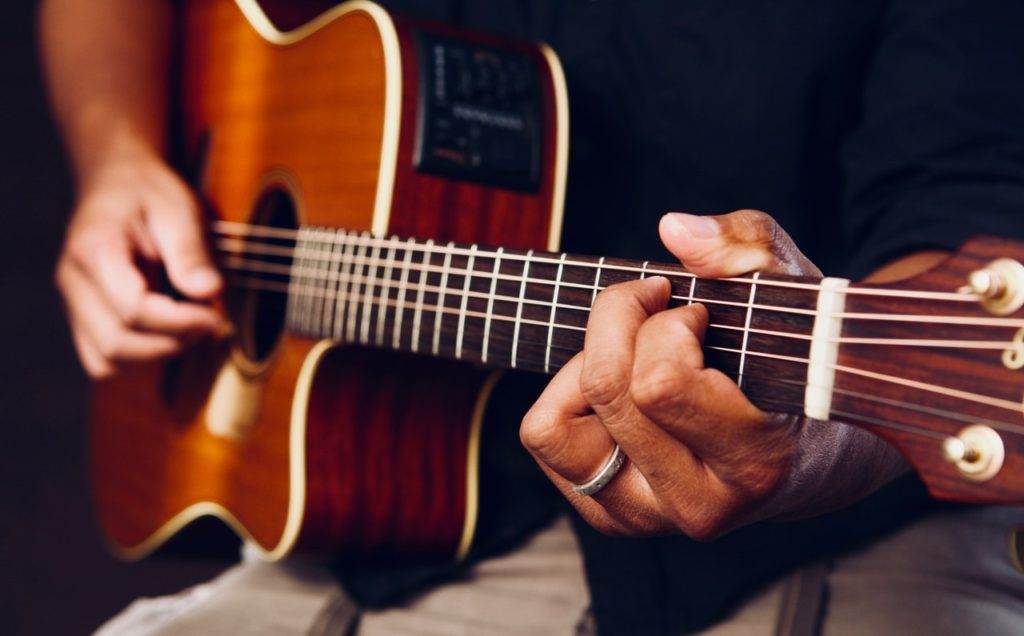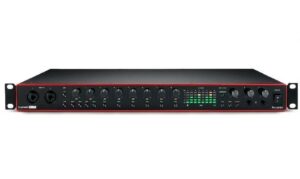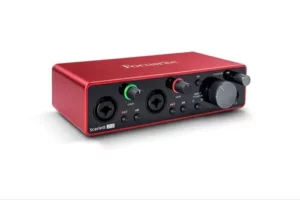Table of Contents
So, you’ve decided that you want a beginner acoustic guitar in your life. It’s a good choice! There’s nothing quite like the soulful sound of an acoustic guitar to express yourself, your fingers strumming along to your favourite tunes. Deciding which one to buy, though, that’s a different beast altogether. Deceptive marketing, dubious reviews, and devious Amazon sellers all have the potential to ruin your day by selling you something that looks like a guitar, but sounds like a buzzy, dull mess.
It’s difficult to do so in the world we’re living in right now, but, if possible, do try to visit a guitar store when shopping around for acoustic guitars. Every piece of wood is different, and there can even be a tonal difference between two guitars of the same model. Additionally, there’s really no substitute for trying out the guitar, feeling it against your body, and visually inspecting it in person. This might be impractical to do in the age of the Coronavirus, so this guide will be geared towards the online side of things.
All things considered; we’ve picked out some of the best acoustic guitars in the market for you.
Here’s the short version.
- Buy either a Yamaha F310 or a Fender CD-60 for a solidly built guitar that’ll age well and stay by your side for your life.
- If you’re on a budget, Grail guitars offer the best bang-for-buck out there.
Our Top Picks For the Best Acoustic Guitars for Beginners
- Fender CD-60
- Yamaha F-310
- Cort AD810
- Squier SA-150
- Ibanez MD-39CDB
- Martin Smith W-101
- Grail Allure A190C
1. Fender CD-60
The Good:
- Walnut fretboard looks and feels really nice to play
- Dreadnought body sounds huge and warm
- The way this ages is just fantastic
The Bad:
- Neck can feel a little thick for some
- Large body may be uncomfortable – see Yamaha F-310 if that’s the case
We’re big fans of this beginner acoustic guitar over here; it has a reputable history, and is made by one of the largest brands out there. The spruce top and laminated mahogany back and sides give this a bright, clear sound and should stand the test of time beautifully.
2. Yamaha F-310
The Good:
- Much more lightweight compared to its Fender competitor
- Great build quality
- Comfortable neck shape
- Bright sound cuts through any noisy environment
- Yamaha uses locally sourced laminate wood for the back and sides, but uses the all-important spruce top for great tone
The Bad:
- Can feel too lightweight at times, so far as to feel fragile
- Sound isn’t as warm as the others
This is a perfect acoustic guitar for beginners; the slender neck is easy to hold, and the lightweight body makes it easy to carry around. The solid top and laminated sides are similar to the Fender guitar mentioned above, but this guitar is much smaller in size, lending itself to feel very comfortable in any situation. Yamaha certainly knows how to make a good guitar, and this is no exception. Only reason to complain about this beginner acoustic guitar is the slightly worrying fact that it sometimes feels too light, and you almost feel afraid to carry it around in case you drop it and crack the wood.
3. Cort AD810
The Good:
- Spruce top, laminated sides. You know the deal
- Cort is a pretty reputable brand, they make many, many instruments for other brands
- Open pore finish feels pleasant in the hands
The Bad:
- Quality & finish could’ve been improved
Cort makes guitars for a ton of brands you may be familiar with, including Ibanez, PRS, and more. This offering from them Feels great to play thanks to low action and a satin open-pore finish, though, the small appointments here and there like the nut and tuners could have been better. Oh well, it plays great and feels good, so we can’t really complain here.
4. Squier SA-150
The Good:
- Thinner neck paired with a dreadnought body is a winning combination
- Build quality is good
- Sounds surprisingly good, all things considered
The Bad:
- All-laminate construction
- Fit and finish continues to suffer as we go lower in price
The Fender Squier SA-150 is Fender’s offering in the more budget market, and it’s a god one. Clean highs and deep, if muddy, lows complement the dreadnought body of this guitar. The quality of the sound suffers from the laminate construction; this is not a guitar that’ll get better with age. However, this is still a pretty decent acoustic guitar for beginners and should make for a good first instrument
5. Ibanez MD-39CDB
The Good:
- Relatively slim body is comfortable to hold
- Cutaway design provides easy high fret access
- Shorter scale length is easier to play for beginners
The Bad:
- Laminate construction
- Sound lacks deep basses
This guitar is the cheapest beginner acoustic guitar that Ibanez makes, and it’s still a decent guitar, considering the price. A truss rod is included, and the sound is punchy and clean. We’d have liked to see some ore output from the low end of the spectrum, but the overall tone remains usable and adequate. The fit and finish you get with this is still pretty good! This is one of the best acoustic guitars under 10,000 .
6. Martin Smith W-101
The Good:
- Comes with a gig bag, a stand, and some other accessories
- Sounds decent
- Truss rod included, which isn’t always a guarantee at this price point
The Bad:
- Laminate construction
- Minor cosmetic flaws here & there
- Sounds just decent, nothing great
Well, it’s an acoustic guitar. It has a truss rod, what more do you want at this price? The playability is actually quite nice, but the sound is just alright, nothing ground-breaking. The body feels good to hold and the neck is slim and easy to play on, too. You get quite the package here if all the accessories are considered. An overall decent package for the beginner looking for a cheap acoustic guitar.
7. Grail Allure A190C
The Good:
- Damn nice sounding guitar
- No, seriously, this sounds really good
- Fit & finish exceeds expectations
The Bad:
- Laminate construction
- Considering the price, not much
This beginner acoustic guitar from Grail sounds way better than it has any right to, even though it has a laminate construction. This is probably the best acoustic guitar available at this point. Even though there’s some cosmetic and playability issues, such as a buzzy fret here and there and relatively high action, the low price and great sound combine to result in a great package.
How to Buy an Acoustic Guitar for Beginners
If you’re on a budget, we’ve got you covered. Here’s some tips on how you can maximize the amount of guitar you get for your hard-earned cash.
Start off by deciding how much you want to fork over. We’d recommend spending at least Rs. 5,000 to get a well-built acoustic guitar that will get better with age and last for years to come. We also recognize the reality that a vast number of students and players out there might not be able to afford that amount of money. Let’s talk about how you can get the most bang for your buck when guitar shopping.
First off, it might be tempting to search on for an acoustic guitar on Amazon, sort by the ascending price and then buy the lowest-priced guitar rated above three stars.
Don’t do this.
Beginner acoustic guitars priced below Rs. 5000 often have missing fundamental features such as a truss rod, have shoddy workmanship, and are built down to a price. Playing these guitars will be difficult and frustrating, and might even lead to a student quitting guitar thinking they’re just not good enough. Such guitars usually can’t be salvaged and improved either, and they won’t respond well to any future attempts to repair them by a luthier. It’s all just a waste of money below a certain price.
Secondly, look out for a few key words, the first of which should absolutely be “truss rod”. A truss rod is basically a metal rod embedded in the neck of a guitar. You see, wood warps and bends in changing temperatures and humidity levels. The wood in a guitar’s neck is also under a lot of tension under steel strings, up to 90 kilograms in total! As you can guess, the neck goes through a lot, and can bend forwards or backwards over time. A truss rod embedded in the neck reinforces it, while also providing a mechanism to even out any bends in the neck.
The next keywords you should be on the lookout for is “solid” & “laminate”. The gist of the whole thing is that a solid piece of wood cut from a single tree is going to sound a lot more resonant than many layers of thin wood glued together. When a laminated wood top is used as the sound board being vibrated by the strings you strum, the glues and polymers used in the lamination process deaden the sound, making the guitar sound a little dull and flat. Perfectly usable, mind you, but not as good as solid top. Laminated sides and backs don’t matter as much to the overall sound of a guitar.
At higher price points, a laminate top should be a deal breaker. You can spot laminate tops by looking at the sound hole of the guitar you’re inspecting. A laminated top will have different colours of wood in the sound hole, while a solid top will have a smooth, consistent colour.
Size Matters
Bigger doesn’t always mean better, though. One man’s “rich and full” might be another man’s “boomy and overpowering”. Smaller guitars, such as concert and parlour guitars have a more mids-focused sound and sound very different to the traditional dreadnought. Try them out to figure out a size that works for you. If your hands and arms are on the smaller side, try out sized tother than a dreadnought, as they can be tough for a beginner to get used to. Every player will have their preferences, and it’s important for you to find yours.
Shop Smart
By the way, at this price point, you should avoid electro-acoustic guitars. These acoustic guitars have a pickup system built in, so you can plug in your instrument to an amplifier. At a low budget, you want every penny you spend to go towards the construction of your instrument; any part of the manufacturing budget going towards the electric pickup system means a smaller chunk of money is left for the guitar. When you’re looking for a cheap guitar, the fundamentals matter.
Try to avoid splurging on unnecessary accessories, such as an expensive leather strap, high-end tuners, or solid cases for your guitar. A basic set of accessories, which’ll include a cloth strap, some picks, a capo, a gig bag, and a stand should be pretty easy and cheap to procure. Something else to avoid is brands that try to knock off other, more popular brands like Gibson, Washburn, or Hohner. These knock-offs have branding reminiscent of better instruments and are usually the worst of the bunch. Look out for brands that embrace original branding, and have their own identity.
The Setup
Whichever guitar you get, it’ll need to be comfortable to play. The next step will be to check the playability of the guitar in your hands.
Start off by checking the action – that is, the distance between the strings and the fretboard. The action on a guitar should only require a moderately light touch to fret a string. If it’s too high, then it’ll be hard for you to play any notes. High action also could mean a bowed neck – this can be fixed with a quick adjustment to the truss rod. Look out for an even, low amount of action across the fretboard. While a higher amount of action provides for a clearer sound, a guitar with low action is ultimately the best guitar for beginners.
Play some chords and notes up and down the neck to see if any notes are buzzing. Any buzzy spots will need to be fixed later, and this is best done with the help of your local luthier.
Time to check the intonation. This refers to the consistency of pitch across the fretboard. Higher frets have a tendency to be off-pitch if the intonation isn’t set up properly. You can quickly check this by playing the 12th fret harmonic, and playing the same note fretted down. Any difference in pitch will indicate that the intonation needs a setup.
In any case, if you can afford a full setup from your local luthier, you should do it. Luthiers have expertise in this area and can help make all the difference in the world.
You should also replace the strings you get on your new guitar if they feel rusted or scratchy.
Types of Woods
The tone you get out an acoustic guitar will depend on a number of factors, but it’ll reside mostly in the shape of the guitar, and the wood the top is made of. Higher quality of woods will result in more resonance in sound and different characteristics, based on the specific wood used. The best budget acoustic guitars are the ones that strike a good balance point between quality and price will have a solid wood top, and laminated sides and back. Higher-end guitars will be made from solid wood sides and backs, too.
Spruce and cedar are the most common top woods, and the sides, back, and fretboards are usually some combination of mahogany, rosewood, and/or maple.
Spruce
The most popular and common choice for an acoustic guitar top wood. Lightweight, yet string and resonant. Yields a clear sound, and can take whatever you throw at it. Versatile and comfortable to play, spruce tops age well, too.
Cedar
Cedar tops have a darker colour in comparison to spruce, with a slight tinge of red creeping through the finish. Cedar tops demand a lighter touch and more finesse in fingerpicking, as the softer wood doesn’t respond too well to hard strumming; the sound becomes compressed, losing its definition and dynamics.
Mahogany
An excellent middle ground between cedar and spruce, mahogany is a time-tested wood to make guitars out of. With the crisp, clean highs and warm lows, you can’t really go wrong with this wood, although these guitars can get heavy.
Maple
Quite a hard, dry wood, the dense Maplewood used in some guitars can produce a clear, highly defined high end. The densest of the woods mentioned here, these guitars can be a pain to carry around, but usually look great if the maple used is quilted or flamed.
Finishes
Most of the beginner acoustic guitars you’ll find on the market will feature natural or clear finishes. Paintjobs on guitars might look nice, but remember that a heavy coat of paint can affect the sound of a guitar. Try to look for a finish where the grain and pattern of the wood used is visible.
Fancy pearlescent inlays, gold-plated hardware, and abalone rosettes on a guitar can certainly add to the beauty of an instrument, but they do not influence the sound of it, at all. Still, if they make you want to pick up your guitar more, they’ll pay for themselves over the years.
Conclusion
All in all, the seemingly daunting task of guitar shopping can be made simple, if you know what you’re looking for. Good luck out there, and remember to have fun!












